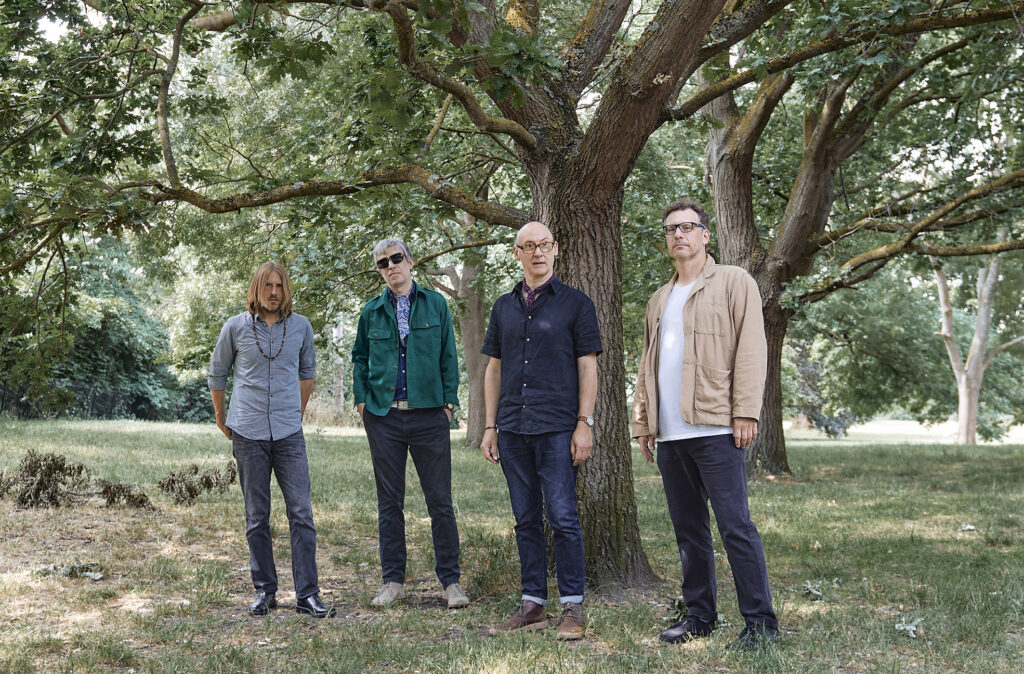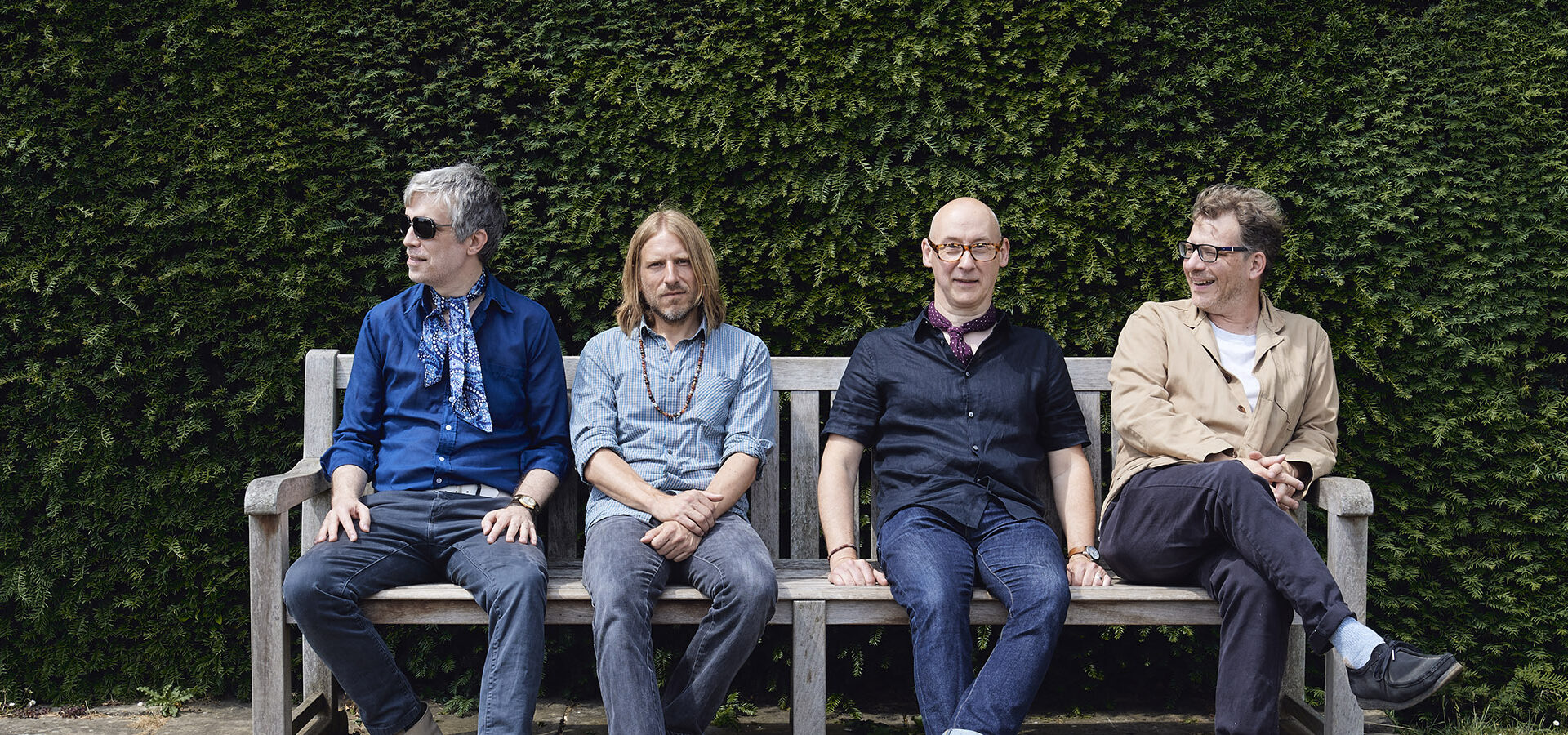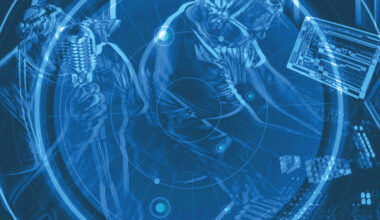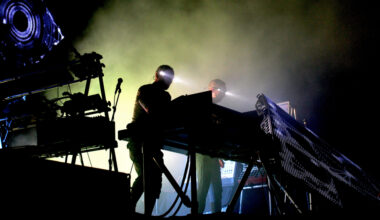For his latest release as Belbury Poly, Jim Jupp has assembled a Ghost Box supergroup with a mid-Atlantic feel. Gathered together for the first time, they discuss ‘The Twilight Zone’, flat-roofed pubs and the fairy folklore that inspired the new record
‘The first track on this album picks up from the final track on a previous Belbury Poly release,” explains Jim Jupp. “They both use a field recording from a wood near my house, by a main road. To me, it’s a very familiar sound – birdsong with early morning traffic. So we’re continuing the fairy folklore themes of that last album, of people being pixie-led and going missing in nature, but this time in a more modern setting.”
It’s a baking hot Sunday lunchtime and the whole Belbury Poly gang is here. It’s the first time they’ve all met in person. And what a curious assortment of people they are – two eccentric Brits enjoying an afternoon of entente cordiale with two equally offbeat Americans. Jim is, of course, co-founder of the Ghost Box label, the politely genial rector of a distinctly unusual parish. He’s accompanied by ever-relaxed bassist Chris Budd, a gin-sipping London lounge lizard in neckerchief and vintage shades.
Also here are fast-talking US beat poet Justin Hopper – resplendent in pork pie hat, tipped at a jaunty angle – and an actual rock star in the shape of Texas-based flautist Jesse Chandler, immaculately frazzled on the final weekend of a month-long European tour with Midlake. Assembled around a pub table in West London, they look like the house band from some strange, long-forgotten Hanna-Barbera cartoon.
Belbury Poly’s new record is called ‘The Path’. As Jim says, it’s a sequel to the band’s 2020 opus, ‘The Gone Away’. Both albums are about fairies – more specifically, the time-honoured fairy predilection for luring unsuspecting travellers off the beaten track to their doom. Even in contemporary cityscapes.
“It reminds me of a conversation I had with my mum about my grandad,” says Chris. “He was once pixie-led in the middle of Hammersmith. You think of it happening in a field, but he was coming out of a cinema in West London, where he grew up. And suddenly, immediately, he just didn’t know where he was. He found his way home eventually, but when Jim started talking about people being pixie-led, grandad’s story made sense. I don’t think I’ve ever been pixie-led myself, but maybe it’ll happen today, on my way home…”
The group approach is important here. ‘The Gone Away’ was an album of Jim’s solo electronica, recorded as a deliberate throwback to Ghost Box’s DIY origins. ‘The Path’ is an expansive musical ensemble piece, a funk and jazz-fuelled odyssey with a transatlantic feel reinforced by Justin’s mellifluous narration. Is this school of oddness something that resonates equally with Belbury Poly’s new Stateside recruits?
Jesse Chandler grew up in Upstate New York, at the foot of the Catskills.
“There’s definitely a spookiness about the Catskills,” he declares. “It’s a very old mountain range, with a lot of lore and ghost stories. My friend and I, growing up in Woodstock in the 1980s, used to go exploring. There was a loop of three or four miles with houses all along it, including ours, but within that loop was a giant forest. So we’d run into hobos, and we once found a pile of heavy metal magazines in there, left in a backpack. Our challenge was to get lost on purpose then somehow find our way home.”
So in the context of ‘The Path’, I wonder, is being “pixie-led” a metaphor for the giddying pace of change in our modern towns and cities? After all, we don’t need the malevolent influence of fairy beings to make us lose our bearings in familiar surroundings. I keep getting lost on the sprawling new housing estate five minutes from my front door.
Jim nods.
“It happens in London all the time,” he says. “The rate of change is just incredible. I lived here for 10 years, and when I come back now – even to the centre – it looks completely different. The roads go in different directions.”
“That’s why we tied together those folkloric elements with that claustrophobic Soho jazz vibe,” adds Justin.
“And it wasn’t intentional,” insists Jim. “But it made perfect sense for this to be, broadly, an Anglo-American project. It took the music in a direction I wouldn’t otherwise have taken. These two cultures know each other intimately, but even today we often don’t know what the hell each other is talking about.”
“It’s a special relationship,” smiles Justin.
My interest duly piqued, I want to dig further into that relationship – the complicated cross-pollination of “two countries separated by the same language”, as George Bernard Shaw once put it.
The genesis of ‘The Path’ arose from long walks across the Sussex Downs, with Jim and the now Essex-based Justin exploring a plethora of narrative ideas. Including, at one stage, a struggling US writer (“Sound familiar?” quips Justin) being driven to mental breakdown by the sheer strangeness of the British landscape.
“One of the very first things Jim and I discussed was the idea of the circular walk,” says Justin. “Always starting and ending in a pub! That’s such a British thing. It made me wonder what would happen if someone like Jack Kerouac was doing ‘On The Road’ – but on a circular walk? That whole sense of freedom and beatnik jazz, forever going forward, forward, forward… it would just turn into this kind of degenerative destructiveness.”
“Our other idea was what I think Justin called a ‘taxonomy’ of weird landscape features,” adds Jim. “Things that seem quite normal to British people. Flat-roofed pubs. Footpaths that just stop. Roundabouts. Motorway signs to ‘The North’! We take all these things for granted, but they’re actually really odd. So we imagined this American guy wandering around the British landscape thinking, ‘What the hell is all this?’.”

The music of ‘The Path’ reflects these dichotomies. It’s American jazz and funk, but filtered through the prism of vintage British film soundtracks and library recordings. The title track in particular feels like a thrilling, distant cousin of Roy Budd’s score to ‘Get Carter’. Jim also cites the influence of eminent British jazzer Michael Garrick, in particular his 1968 recording, ‘Prelude To Heart Is A Lotus’. Jesse, listening intently, admits he’s been fascinated by the contrasts between the two schools.
“I grew up listening to and emulating American jazz,” he says. “But in the last decade or so I’ve heard some of the more obscure British artists. There’s a sense of freedom among the Americans, an effortlessness in how they play. Here, it’s maybe a little more constructed, more thought-out. It’s no less musical, but it’s coming from a different angle.”
That’s probably because all British people are deeply repressed, I suggest.
“Should we perhaps say ‘mannered’?” protests Chris. “But yes, the music is often very spare. It’s jazz at its fighting weight. That cinematic element is important too. This was functional music doing a job, and I responded to that.”
It’s weird though, isn’t it? In the US, jazz is seen as the ultimate in musical expression. In Britain, we grew up hearing it as the background music for the test card on BBC Two. I remind Jim that, the last time we spoke, he cited the jaunty theme from ‘One Man And His Dog’ as an important formative influence on the early sound of Belbury Poly.
“TV themes are never far away from any Ghost Box album,” he admits. “I know we talk about this all the time, but there’s something really evocative about them.”
“Well, they’re repetitive, aren’t they?” ponders Chris. “You might hear a film score once or twice, but how many episodes of ‘Man About The House’ were there? TV themes lodge in your head through familiarity.”
“I think it might be necessary for someone to explain to Jesse what ‘One Man And His Dog’ is,” interjects Justin.
“OK…” says Jim, taking a deep breath. “In this country, farmers train border collies to herd sheep using all kinds of whistles and hand signals, and it’s done at the level of a competitive sport. So every week – on primetime TV, on one of our three channels – we’d watch organised sheep-herding. ‘Come by’! At the end of the show, the sheep ended up in a little square pen, and you’d hear a ripple of applause from across the fields. But it also had this laid-back, jazzy synth music as its theme.”
“Did this compete on television with snooker?” asks an incredulous Jesse.
It competed on television with everything. It ran for nearly 40 years.
“Netflix has got it now,” deadpans Chris.
We’re being lured off the conversational trail here. There’s also a danger of being sidetracked by Jesse’s new-found love of mushy peas (“I’m a fan of peas in general, but those… wow”) and Chris’ appreciation of vintage ‘Sesame Street’ animations.
Instead, let’s talk about Justin’s honey-voiced narration of ‘The Path’. Ultimately only loosely tethered to that initial narrative of a landscape-inspired breakdown, it nevertheless follows a grand tradition of American beat poetry edging curiously close to the mainstream. Alongside solemn warnings about straying into fairy realms (“One step into the stray sod and you’re committed to the cause”), there are soliloquies about the lingering potency of childhood flying dreams and the mystical properties of moths.
“It’s entirely serious,” says Justin. “Except it’s also a tiny bit tongue-in-cheek. Does that make sense? It’s dramatic and beatniky and everything, and that’s sort of funny. But it’s also 100 per cent for real.”
He stresses the influence of Ken Nordine, the great mid-20th century voiceover man, whose surreal 1967 spoken-word album ‘Colors’ had its origins in a series of jazz-influenced paint commercials.
“Because of my background, I have a real love for what I think of as middle-class, middle-20th century, Middle America,” explains Justin. “My grandparents were from the Mid-West, basically dirt farmers who became middle class, and for them everything was middle-of-the-road. But Ken Nordine made a really psychedelic version of that. A version that’s fucked up.”
“There’s something of Rod Serling’s introductions to ‘The Twilight Zone’ about your narration as well,” adds Jim.
“Rod Serling was my single biggest influence on this album,” nods Justin. “I went to the same high school as he did. ‘The Twilight Zone’ has lots of stories about very ordinary people descending into madness, having bizarre things happen to them. Things they can’t explain to anyone else. And, knowingly and unknowingly, a lot of what happens on this album was about capturing that kind of feeling.”
Musically, the album has clearly been a hugely collaborative exercise.
“I made some fairly simplistic demos,” explains Jim. “I knew at least half the tracks would have a backbone of drums and bass guitar. I actually based a couple of demos on the kind of breakbeat samples DJs were using in the 1990s, then passed them around for everyone to lay down their own arrangements.”
“Should we talk about the colour-coded spreadsheet?” asks Jesse. “This is the most efficiently recorded album I’ve ever been part of.”
“That’s because I’m so uptight!” laughs Jim. “It was just a list of tracks, with the sessions that needed doing and who was going to do them.”
He’s keen to praise the contribution of session drummer Max Saidi, perhaps the only Ghost Box recruit to have previously worked with both Peter Andre and Will Young, and who came on Chris’ personal recommendation. The enduring relationship between Jim and Chris seems pivotal to the cohesive feel of ‘The Path’.
“Jim and I have been friends for decades,” says Chris. “Our wives went to university together, and now we’re a gang. I’m always keen to get involved with Ghost Box, even though Jim’s actually quite a good bass player and he doesn’t really need me. I remember turning up at his studio one day and he said, ‘Look, I’ve bought a bass!’. And I thought, ‘Oh, fuck…’.”
For Justin too, the cooperative nature of the work was clearly a very rewarding experience.
“The tracks with my words were composed in tandem, back and forth and back and forth, in a way that was really special,” he says. “It was much more of a collaborative project than most things of this ilk. If you listen to older poetry records, it’s just someone playing music and someone else reading poetry, but that’s very much not what happened here.”
Even as we speak, creativity is fizzing around the table. Jesse reveals that his next Ghost Box album, recorded under his regular nom de plume, Pneumatic Tubes, will be based around the pseudo-spiritual aspects of the 1980s jogging craze.
At the same time, he divulges, he’s partnering with Justin on a theatrical performance inspired by the legacy of actual pneumatic tubes – the hydraulic mailing system pioneered in department stores in the late 19th century. Jim is clearly proud of the gloriously offbeat projects being moulded together by his label’s disparate alumni.
“Since this thing started coming together, it’s been nice to think about Ghost Box having a ‘stable’,” he says. “There’s something really cool about that. Like the Wrecking Crew…”
“Yeah,” agrees Justin. “But it’s the Wrecking Crew if everyone in the Wrecking Crew lived in the middle of nowhere and shunned the outside world.”
It’s time to go. The company breaks up and we begin to forge our separate paths into the twisting alleyways of West London. Jesse, on his last afternoon in the UK, is off to do a soundcheck for a solo show in a nearby basement venue. Justin and Jim go in search of the latter’s mysteriously elusive Premier Inn.
And Chris? Who knows. Perhaps he finally fulfils that long-standing ambition to be pixie-led around the streets of Hammersmith. If he has vanished for good, let this be his epitaph… extensive research reveals there were actually 39 episodes of ‘Man About The House’.
‘The Path’ is out on Ghost Box






